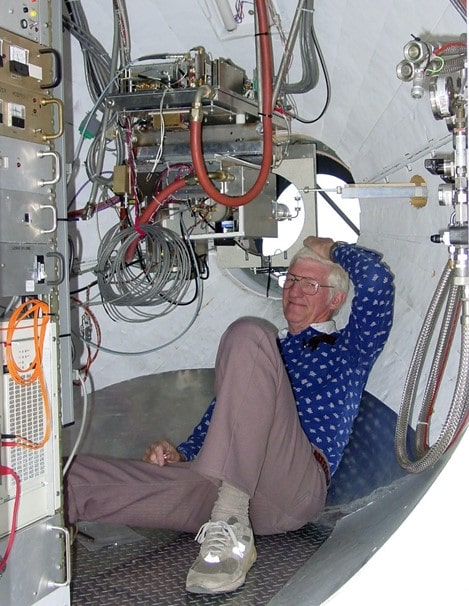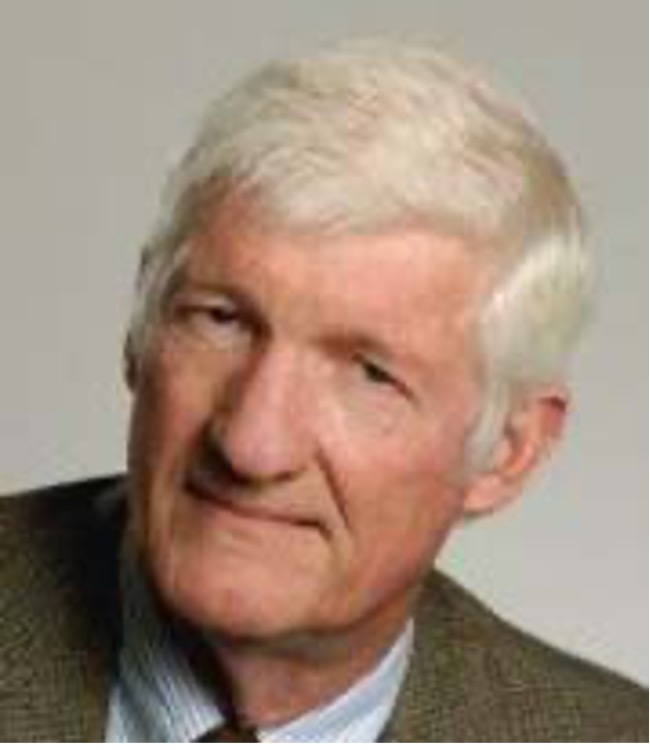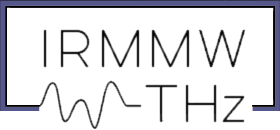Jack Welch
William John (Jack) Welch (1934-2024)
Jack Welch pioneered the field of millimeter-wavelength astronomy, discovered the first polyatomic molecules in space, and was a strong advocate of SETI
by Imke de Pater, Jean Turner, Eric Welch and Carl Heiles
William John (Jack) Welch, emeritus Professor in both the Departments of Astronomy and of Electrical Engineering and Computer Science (EECS) as well as former Director of the Radio Astronomy Laboratory at the University of California at Berkeley, died on March 10, 2024, at the age of 90.
Jack was a highly skilled experimental radio astronomer who played an important role in the discovery of polyatomic chemistry in interstellar gas and in the development of millimeter and submillimeter interferometry, which paved the way for the Atacama Large Millimeter/Submillimeter Array (ALMA). He was also the principal designer of the Allen Telescope Array at the Hat Creek Observatory, which serves as
a model for large, lower frequency observatories such as the Square Kilometer Array.
Jack’s contributions to radio science were recognized nationally and internationally, including his election to the National Academy of Sciences in 1999, the Jansky Lecturer Award in 2001, and the URSI Balthasar van der Pol Gold Medal in 2008. Jack also held the Marilyn and Watson Alberts Chair for the Search for Extra Terrestrial Intelligence (SETI) at UCB between 1998 and 2011.
Jack was born on January 17, 1934, in West Chester, Pennsylvania. His ancestors had developed the Welch Food Company, which pressed, bottled and sold Welch’s Grape Juice. Jack’s great-grandfather, Thomas Bramwell Welch (1825 [England] –1903 [Philadelphia]) invented the Juice by applying the work of Pasteur to keep it fresh. Jack’s grandfather, Charles Edgar Welch (1852 – 1926) made Welch’s a commercial success. Charles had five sons, the youngest was Jack’s father, William Taylor Welch (1890 – 1961), ran a manufacturing business called Ajax Flexible Coupling.
William (Jack) Welch moved away from the business activities of his father and grandfather by pursuing an academic career. He was an undergraduate at Oberlin and transferred to Stanford University to obtain a BA in Physics in 1955. He accomplished his Engineering Science Ph.D. in 1960 at the University of California, Berkeley, studying Antennas. As a newly minted engineering Ph.D., he received three unsolicited job offers: Bell Labs, Dartmouth and Berkeley; perhaps a Ph.D. in Engineering Science was ideal for the post-Sputnik era. Thanks to his liking of the Californian weather and his passion for tennis, Jack chose Berkeley, and joined the faculty of UCB’s Electrical Engineering Department (which now includes Computer Science – the EECS Department) in 1960. With his keen interest in electromagnetics, he soon formed a natural symbiotic coupling to Berkeley’s Radio Astronomy Laboratory (RAL), which just two years earlier had been founded by Professor Harold Weaver in the Department of Astronomy as one of the first Organized Research Units.
In 1971 Jack became a 25% faculty member in the Astronomy Department, and at about the same time started serving a 25-yr long term as the Director of RAL. In 2005, when RAL’s millimeter antennas were moved to Cedar Flat (CA) and combined with Caltech’s antennas to form the Combined Array for Research in Millimeter-wave Astronomy (CARMA), Jack retired from both departments.
In the late 1960’s Jack and physics Professor Charles Townes, together with their graduate students, made the first detections of ammonia and water in the interstellar medium (ISM) using RAL’s newly commissioned 20-ft radio telescope at UCB’s Hat Creek Radio Observatory. They also used this telescope to detect ammonia gas closer to home, in the planets Jupiter and Saturn. Over the next decades, this seminal discovery of the first polyatomic molecules in space triggered the detections of dozens of additional interstellar molecules by astronomers, enabled detailed studies of star formation in interstellar clouds, and launched the field of astrochemistry. Before these detections, the conventional wisdom had been that nothing larger than a diatomic molecule could be formed in interstellar clouds. We now know that nothing could be further from the truth. We can have plentiful molecules as complex as alcohols, sugars, and amino acids in molecular clouds. For complex molecules to be so plentiful, not only must they form efficiently via extensive chemical networks and solid-state surface reactions on interstellar dust grains, but also must be shielded from destruction and dis-association due to stellar ultraviolet radiation by those same grains. The implied gas densities were much higher than those expected or implied by previous observations of the ISM, even high enough to form new stars.
When Jack saw the connection between dense molecular gas and star formation, he realized the importance of mapping the structure and kinematics of the dense molecular gas – and that this could only be accomplished by mapping emissions from rotational lines in cold molecular clouds. Such lines are present only at millimeter wavelengths. Accordingly, moving to higher radio frequencies was key to mapping the dense molecular gas. Consequently, Jack led the development of the Hat Creek Interferometer to become the first millimeter-wave interferometer.
Observations with this instrument provided the first maps of molecular line emission at arcsecond resolution in massive star forming regions, including important studies of molecular line and maser emission in Orion, W49, K3-50, and W3(OH). Jack was the first to recognize that there were “too many compact HII regions” in the giant star-forming region W49 to be consistent with their dynamical ages, and that some mechanism must inhibit their expansion. In addition, Jack’s insisted that there was a stellar object at the position of the water masers in W3(OH) in spite of a lack of infrared continuum emission, even at wavelengths as long as 30 microns. Jack and his student discovered a hot molecular core in HCN emission at this location. The extremely high extinction toward this young protostellar object ruled out most infrared observations and foretold the need for interferometry at submillimeter wavelengths.
Jack left a lasting legacy as the pioneer in the field of millimeter wavelength interferometry, first by building the Hat Creek Interferometer, then expanding it into the Berkeley-Illinois-Maryland Array (BIMA). The success of these instruments led to the construction of even more capable telescope arrays – CARMA, and ultimately the Atacama Large (sub)Millimeter Array (ALMA). Jack served as chair of the advisory committee for the Smithonian’s Submillimeter Array (SMA) for a remarkable 13 years (1989-2002), providing invaluable guidance through the construction of this interferometer. With the SMA, as with many of his other projects, Jack was always upbeat with positive suggestions and encouragement, no matter how grim the situation appeared. This is the Jack that many of his former students and colleagues remember.

Maryland Array. Credit: Jill Tarter.
Jack’s realization of the biological importance of his detection of the first two molecules in space was related to the Miller-Urey experiment (amongst others) that showed the synthesis of amino acids when sparked by electric pulses. As the first to hold UCB’s chair for the search for extraterrestrial intelligence (the Marilyn and Watson Alberts Chair), he emphasized the importance of seeking intelligent life beyond Earth and advocated that SETI was a legitimate science. He was one of the founding members of the SETI Institute’s Board of Directors. After Jack’s retirement in 2005, he moved on and played a central role in the design and development of the Allen Telescope Array (ATA), the first observatory built specifically to conduct SETI research.
Jack’s enthusiasm, kindness, and guidance inspired many students who went on to make their own contributions to radio astronomy. Jack was always friendly and approachable, exceptionally kind, and trusting; He really had a knack to bring out the best in people. In addition to teaching courses in EECS and Astronomy, he sometimes taught a full radio astronomy course to just a single graduate student, if the student showed an interest in the field. He also was generous with his time, and on occasion loaned, for several years, his (expensive) equipment to graduate students in other departments. RAL, under Jack’s leadership, was a thriving place, with incredibly talented staff and students. The atmosphere was pleasant, conducive to perform one’s best work, whether it was building equipment and/or using the telescopes for science. A total of 27 students obtained their degree under Jack’s guidance. Numerous social events were organized at Jack and (his wife) Jill’s house, a tradition that had been started by the former Director (and Founder) of the Radio Astronomy Lab, the late Professor Harold Weaver.
In addition to being passionate about building the most capable telescopes, he loved flying. In the early 60s he co-founded a group called the “Astronomical Flying Society”. A major reason for the club was to fly to and from Hat Creek, instead of driving back and forth. Jack was an expert pilot with a masterful ability to confront emergency situations: he once made a forced landing after the engine seized and the windows fogged up in the mountainous terrain of western Colorado when he glided the plane down to land on a jeep road. An impressive accomplishment, remembered by many people – especially those who were passengers in the plane! He ultimately sold his Cessna to help fund construction of the ATA.
Jack is survived by his wife, Jill Tarter; his former wife, Juliet Wilson Welch; his son Eric, daughters Jeanette and Leslie, and step daughter, Shana Tarter. Jack died peacefully at home, with Jill at his side. Just two hours earlier, his son was visiting, and his two daughters were on Zoom from their homes across the country.
Jack leaves a legacy that transcends his contributions to radio astronomy, astrochemistry, and the search for extraterrestrial intelligence. His pioneering spirit, dedication to scientific exploration, and impact on the field will be remembered and celebrated by colleagues, students, and the broader scientific community. He will be greatly missed.

Year:
